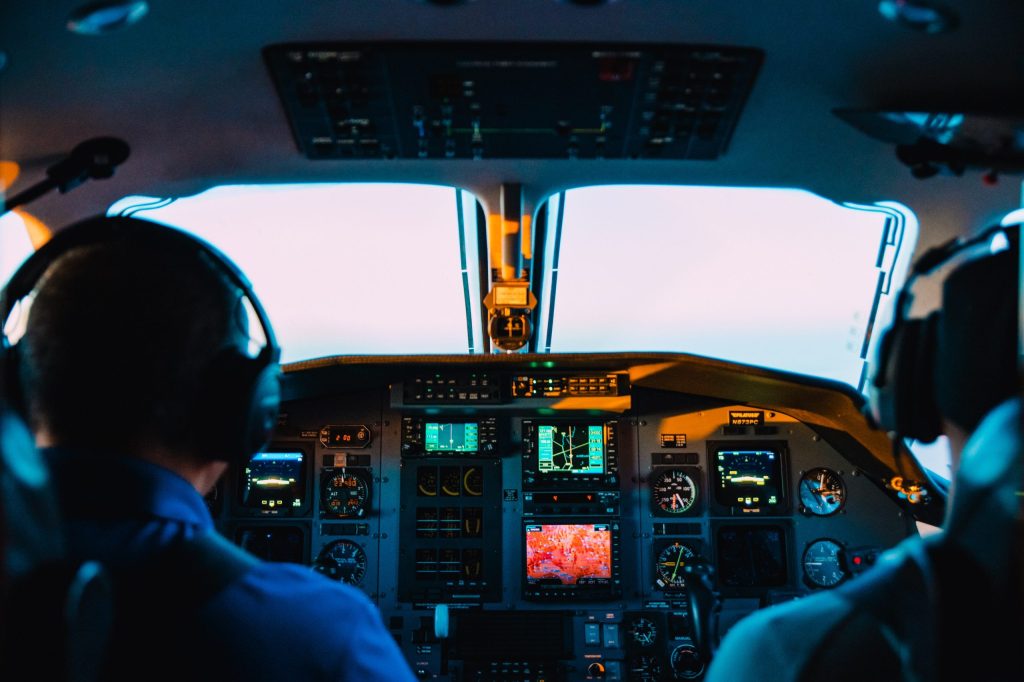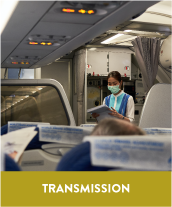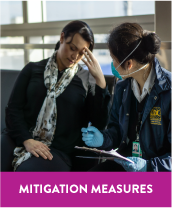Airport Stakeholders: Guide

Airline Management and Staff
Staffing Shortages and Shift Management
According to the Department of Homeland Security (DHS), essential workers are those who conduct a range of operations and services that are typically required to maintain critical infrastructure operations,1 including airport operations. During the COVID-19 pandemic, multiple airports struggled to sustain operations with reduced staff. Reductions were in part due to staff getting sick and/or being exposed and needing to quarantine or isolate. To protect essential workers who were coming in daily, such as janitorial, maintenance, and security staff, some airports modified shifts and adjusted postings to accommodate social distancing requirements. Some revised their shift turnover procedures to be virtual (e.g., web meetings) so there would be no in-person overlap. While this helped keep staff safe, it created opportunities for communication failure regarding tasks and priorities for the incoming shift.
One airport mentioned that staffing shortages led them to declare an Operational Contingency Level event. The Operational Contingency Level was declared an Air Traffic Control-Zero (ATC-zero)—a Federal Aviation Administration (FAA) designation that a facility is unable to safely provide published air traffic services or traffic flow management in the case of the Air Traffic Control System Command Center.2 This led to the airport temporarily shutting down all operations and routing all incoming aircraft to different airport facilities.
Transition to Telework
Teleworking is the practice of primarily working from home, making use of the internet, email, and the telephone. Many airport leadership teams struggled to implement and transition to telework. Making quick adjustments to identify who was essential and who was not proved to be time-consuming, and the need for support, guidelines, and tools for telework implementation also complicated the transition. Additionally, many workers supporting operations were not technology savvy and needed to be trained by the information technology (IT) department on how to use technology and software for telework.
The adaptation to telework resulted in an increased request for IT resources and increased costs for technology and administration to set up a robust capability to work from home. Multiple airports mentioned significant administrative work was needed early on. This included ensuring cybersecurity measures were set up correctly for all staff, implementing changes to software to enable remote access, and providing access to programs such as business management software. The IT departments and service desks spent additional hours beyond their regular shifts on the phone, instructing employees how to use the technology and providing them with access to servers and data as needed. Additionally, all training transitioned to virtual meetings, which made it less interactive and more difficult to fully engage staff. The transition also created a financial burden for airports to cover both the cost of recruiting and hiring more IT personnel, as well as the additional technology needed for those teleworking from home.
Incorporating collaborative technology (e.g., shared online spreadsheet tools, video conferencing) to empower airport teams to function in a remote environment was deemed important. Multiple airport employees used these programs concurrently for many functions including remote collaboration and easy information sharing.
Employee Incentives
Multiple airports and airlines had the opportunity to offer financial incentives to their employees for getting tested weekly. For example, one airline offered monetary incentives to their employees through their health and wellness benefits, provided one million free COVID-19 tests, and provided paid time away from work for employees exposed to COVID-19. Some airports offered their employees paid time off from work to get tested. For some airport employees that tested positive or exhibited symptoms, up to 80 hours of paid leave was provided. Once most employees were vaccinated, many airports reduced these benefits to 40 hours of paid leave.
Aviation Organizations
Aviation organizations such as the American Association of Airport Executives (AAAE), Airport Council International World (ACI World), and the International Civil Aviation Organization can play a significant role in providing advice to airports and sharing information and best practices across stakeholders. Multiple airport authorities expressed their reliance on organizations such as ACI World for global communication and AAAE for communicating real-time updates on local exposure risks regarding the pandemic. Many smaller regional and general aviation airports had biweekly calls with external emergency management working groups to share best practices and lessons learned.
Federal, State, Local, Government
Communication with Government Authorities
Airports highlighted the importance of meeting with federal and state government authorities to better respond to the pandemic in a consistent and more unified manner. These efforts included meeting virtually with city leaders and officials, participating in city-wide communications, and attending sponsored DHS calls. The discussions enabled information sharing about the spread of the virus and pandemic mitigation measures to help airports and local authorities better plan and prepare for the response.
Airports that already had developed strong relationships with the FAA, CBP, and TSA mentioned that these relationships were instrumental in helping guide them during the initial phases of the COVID-19 pandemic. Although only a couple of airports had a Center for Disease Control and Prevention (CDC) representative onsite to provide guidelines, staff from those airports that did have a CDC representative noted that sharing information about the benefits of such contacts during calls with the AAAE or ACI was helpful for other airports. Airports that already had developed relationships with their local fire department, local hospitals, and law enforcement felt they were in a better position to provide medical services and supplies to their customers, employees, and tenants. Communicating with state and local health officials, as well as federal entities such as the CDC, is also important for airports during public health emergencies.
Airport Government Liaison
Some airports dedicated a liaison employee to maintain communication with the local, state, and federal health agencies during the pandemic, while others brought in medical doctors and experts in epidemiology from local medical facilities to communicate risks and best practices to their staff. During a 2019 ACRP Insight Events Presentation,3 Dustin Jaynes, Public Health Administrator and Chief Epidemiologist at Dallas/Fort Worth International Airport (DFW) explained how Dallas/Fort Worth International Airport (DFW) used health education materials developed by the CDC to inform first responders about the Ebola virus disease transmission modes and how to recognize the preliminary symptoms of the disease. The airport also consulted with expert medical professionals, Doctors Without Borders, public health agencies, the World Health Organization, and other organizations to provide informational materials to first responders.
Communicating frequently with local, state, and federal government agencies, as well as public health and aviation organizations helps airports better understand and stay informed of the policies and procedures for a communicable disease response. During steady state operations or a communicable disease outbreak, having a working relationship with governmental, non-governmental, and medical entities will help the airport authorities ensure they are obtaining the most reliable information about local disease threats, modes of transmission, and mitigation best practices.
Public Health Entities
Public Health and Medical Professionals
Some airports found that having daily touchpoints with medical facilities helped the airport leadership team understand how to protect themselves and help mitigate the spread of COVID-19 during pandemic operations. One airport was able to make connections with an infectious disease doctor from a local university and utilized their expertise and advice to review many of their policies, protocols, and prevention plans in response to the pandemic. Multiple airports were able to partner with their local public health department to ensure information from different channels was being communicated accurately. Relationships with these entities should be built during both steady state and emergency operations.
Traveling Public
Infected Passengers
Airports had to develop protocols for the management of infected passengers. These protocols often included three primary elements: removal of the passenger from the plane using appropriate personal protection equipment (PPE), isolation of the passenger from other employees and passengers, and transportation of the passenger to a medical facility. Airports also helped coordinate the isolation and disinfection of aircraft and sometimes coordinated with the fire department to facilitate transportation of the infected person to a medical facility. Some airports noted that it was easier to determine infection status for international passengers due to testing required when arriving in the country.
Tenant/Concessionaire Staff
Communicating with Airport Employees and Tenants
Tenants and employees expect airport management staff to provide the most up-to-date information on communicable disease threats that impact their operations, as well as effective guidelines and policies for how to execute their work safely during a pandemic. This includes comparing all the guidelines and strategies provided by the different government entities such as the CDC, TSA, and the federal, state, and local health officials and translating them into the airport’s continuous operations and protocols. Taking on the responsibility of evaluating these guidelines will ensure the employees and tenants know exactly what their role is and how to respond to a communicable disease threat at the airport facility, minimizing the effect on the operations. During the interviews conducted for this study, multiple airport officials described the topics discussed in their daily meetings conducted with key stakeholders, including updates on COVID-19 information, policy changes, best practices, data acquisition on positive cases, and different resources available to their tenants and employees.
[1] Department of Homeland Security. (2022). “Identifying Critical Infrastructure During COVID-19.” https://www.cisa.gov/topics/risk-management/coronavirus/identifying-critical-infrastructure-during-covid-19
[2] Artist, M. C. (2020). “Air Traffic Control Operational Contingency Plans.” Federal Aviation Administration. Retrieved September 14, 2022, from https://www.faa.gov/documentLibrary/media/Order/JO_1900.47F_Final.pdf
[3] Wilhelmi, J. (2019). TRB Conference Proceedings 55: Airport Roles in Reducing Transmission of Communicable Diseases. Summary of a Workshop of the Airport Cooperative Research Program’s 2018 Insight Event. Transportation Research Board, Washington, DC. https://doi.org/10.17226/25367
Banner image credit: Unsplash



